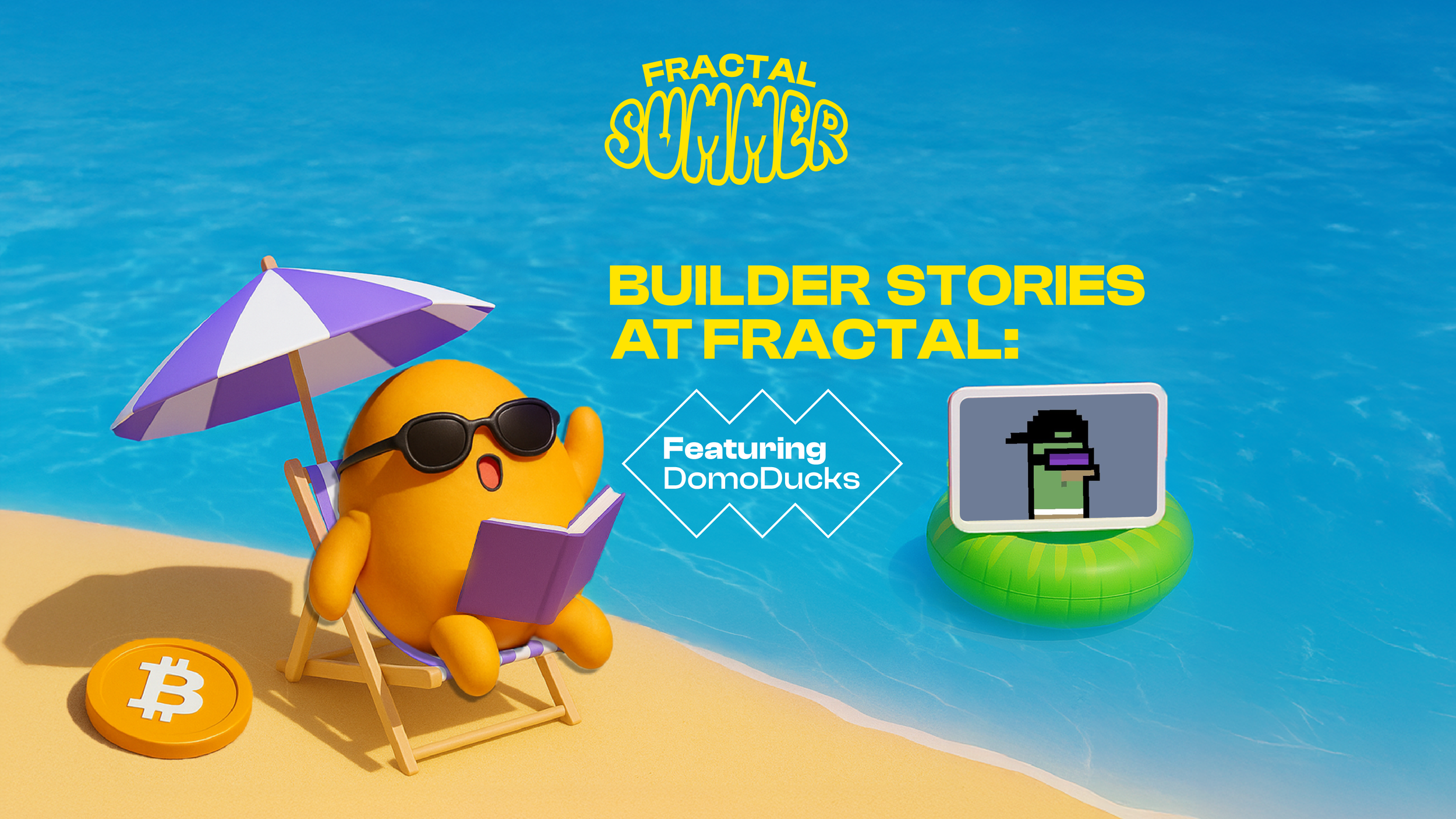DomoDucks: Pioneering On-Chain Art Provenance and Multi-Parent Breeding on Bitcoin and Fractal
What happens when you combine innovative provenance exploration and creator-first principles?
DomoDucks emerges as a project that's pushing forth on-chain art provenance on both Bitcoin and Fractal Bitcoin. From Inscription #256 to multi-generational breeding system, dive into DomoDuck's journey:
What were you building before building on Fractal?
In the world of art, the significance of provenance cannot be overstated; therefore, at the heart of DomoDucks lies a creative exploration of provenance:
“Provenance is the silent witness to a work’s journey through time; it speaks when the canvas cannot.” —A. Hyatt Mayor (1971)
The DomoDucks journey began with Inscription #256, namely the first image of a duck inscribed on Bitcoin. And every aspect of our quest is directly and inseparably tied to this central point of origin. For example, we pioneered the first example of on-chain male/female breeding via multi-parent-child provenance on Bitcoin such that each successive generation can trace the lineal descent of their family tree to this initial progenitor.
What wasn't working? What was your biggest fear about building on Bitcoin before Fractal?
I can tell everyone from experience that testing and troubleshooting code on L1 Bitcoin is very expensive. I've created single inscriptions that cost nearly $500 in fees, so when it came to testing new concepts, there was always a degree of fear regarding how many test inscriptions would be necessary to finalize the design.
Walk us through your first day building on Fractal. What surprised you?
I've been experimenting on Fractal from day one. In fact, I was able to get in early enough to create Inscription #5050. The chain was extremely congested that day, so the network fees were completely maxed out from competition. Despite this fact, I wanted to secure 256 Early Commemorative Inscriptions, so I pushed forward. Ultimately, I was able to inscribe all of these high-resolution images that day (~140 KB each) for a total of about $2k. This figure might seem like a lot, but you have to keep in mind that this was under maximum network load, and also consider that the price on Bitcoin, even with fee rates of 1 sat/vB, would have easily been more than $50k. So I was actually quite surprised and impressed with how well the network held up under such extreme conditions.
What's the biggest technical challenge you faced, and how did you solve it?
I wanted to find a way for each of these 256 Early Commemorative Inscriptions to possess on-chain provenance, but at this stage no Fractal UI existed to create parent-child provenance. Therefore, I reached out to the Fractal team regarding this matter, and they developed a public UI for this purpose. Once this resource was available, I inscribed an HTML file directly under Inscription #5050 to document all 256 Early Commemorative Inscriptions—thus chronicling all of them together on-chain as a cohesive unit. This inscription can be viewed below (as you can note, it has since been sent to Satoshi's wallet): https://ordinals.fractalbitcoin.io/content/5564e0402cd25efb8339715598946bb11d62120923b98be7bc4ed73d82928bf8i0
When did you realize "this actually works"?
The fact that Fractal already has a UI for multi-parent-child provenance and that the relations are all properly indexed on their ordinals.fractalbitcoin.io explorer revealed to me the true potential. It took more than a year for the Ord client on Bitcoin to properly index multi-parent inscriptions, and some of the major explorers (like ord.io) still don't display these relations, so the Fractal team is moving at lightning speed.
What's the coolest thing your app can do that surprises even you?
Our DomoDucks (Indelibly) collection has the third largest all-time volume on the Fractal marketplace. As with our Bitcoin collections, it incorporates the use of parent-child provenance. And I was able to develop an algorithmic application that allows holders who own at least 5 Child Stamps to recursively reference all of them into a single Glitch Stamp animation composite that's inscribed below each one as a multi-parent inscription which randomly swaps between them with a random time-duration window of 70–130 milliseconds per frame. This mechanism can be utilized to reward holders at no cost to them (in a similar fashion to an airdrop) via on-chain breeding.
How much did you save in development costs compared to building elsewhere?
I've saved thousands of dollars using Fractal as a test layer — plus, it's a lot of fun. For instance, it would have cost me $370 to inscribe the above-described algorithmic application on L1 Bitcoin. With this in mind, consider that the 30+ test inscriptions (created during the development process) on Fractal only cost me around 1 cent or less. On Bitcoin, those 30 tests would cost more than $11k ($370 x 30 = $11,100).
Conclusion
DomoDucks has become a standout example of what’s possible when creative ambition meets technical experimentation. With over 256 high-resolution inscriptions and a functional use of parent-child provenance, the project has pushed the boundaries of Ordinals-based collectibles in a way that’s both practical and verifiably on-chain.
Explore DomoDucks: https://fractal.unisat.io/market/collection?collectionId=domoducks-indelibly
Follow DomoDucks on X: https://x.com/DomoDucks


